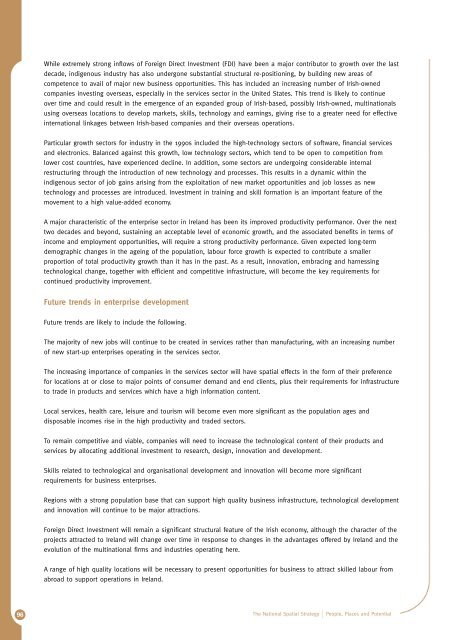National Spatial Strategy For Ireland 2002 - 2020 - Full ... - Kildare.ie
National Spatial Strategy For Ireland 2002 - 2020 - Full ... - Kildare.ie
National Spatial Strategy For Ireland 2002 - 2020 - Full ... - Kildare.ie
You also want an ePaper? Increase the reach of your titles
YUMPU automatically turns print PDFs into web optimized ePapers that Google loves.
96<br />
While extremely strong inflows of <strong>For</strong>eign Direct Investment (FDI) have been a major contributor to growth over the last<br />
decade, indigenous industry has also undergone substantial structural re-positioning, by building new areas of<br />
competence to avail of major new business opportunit<strong>ie</strong>s. This has included an increasing number of Irish-owned<br />
compan<strong>ie</strong>s investing overseas, especially in the services sector in the United States. This trend is likely to continue<br />
over time and could result in the emergence of an expanded group of Irish-based, possibly Irish-owned, multinationals<br />
using overseas locations to develop markets, skills, technology and earnings, giving rise to a greater need for effective<br />
international linkages between Irish-based compan<strong>ie</strong>s and their overseas operations.<br />
Particular growth sectors for industry in the 1990s included the high-technology sectors of software, financial services<br />
and electronics. Balanced against this growth, low technology sectors, which tend to be open to competition from<br />
lower cost countr<strong>ie</strong>s, have exper<strong>ie</strong>nced decline. In addition, some sectors are undergoing considerable internal<br />
restructuring through the introduction of new technology and processes. This results in a dynamic within the<br />
indigenous sector of job gains arising from the exploitation of new market opportunit<strong>ie</strong>s and job losses as new<br />
technology and processes are introduced. Investment in training and skill formation is an important feature of the<br />
movement to a high value-added economy.<br />
A major characteristic of the enterprise sector in <strong>Ireland</strong> has been its improved productivity performance. Over the next<br />
two decades and beyond, sustaining an acceptable level of economic growth, and the associated benefits in terms of<br />
income and employment opportunit<strong>ie</strong>s, will require a strong productivity performance. Given expected long-term<br />
demographic changes in the ageing of the population, labour force growth is expected to contribute a smaller<br />
proportion of total productivity growth than it has in the past. As a result, innovation, embracing and harnessing<br />
technological change, together with effic<strong>ie</strong>nt and competitive infrastructure, will become the key requirements for<br />
continued productivity improvement.<br />
Future trends in enterprise development<br />
Future trends are likely to include the following.<br />
The majority of new jobs will continue to be created in services rather than manufacturing, with an increasing number<br />
of new start-up enterprises operating in the services sector.<br />
The increasing importance of compan<strong>ie</strong>s in the services sector will have spatial effects in the form of their preference<br />
for locations at or close to major points of consumer demand and end cl<strong>ie</strong>nts, plus their requirements for infrastructure<br />
to trade in products and services which have a high information content.<br />
Local services, health care, leisure and tourism will become even more significant as the population ages and<br />
disposable incomes rise in the high productivity and traded sectors.<br />
To remain competitive and viable, compan<strong>ie</strong>s will need to increase the technological content of their products and<br />
services by allocating additional investment to research, design, innovation and development.<br />
Skills related to technological and organisational development and innovation will become more significant<br />
requirements for business enterprises.<br />
Regions with a strong population base that can support high quality business infrastructure, technological development<br />
and innovation will continue to be major attractions.<br />
<strong>For</strong>eign Direct Investment will remain a significant structural feature of the Irish economy, although the character of the<br />
projects attracted to <strong>Ireland</strong> will change over time in response to changes in the advantages offered by <strong>Ireland</strong> and the<br />
evolution of the multinational firms and industr<strong>ie</strong>s operating here.<br />
A range of high quality locations will be necessary to present opportunit<strong>ie</strong>s for business to attract skilled labour from<br />
abroad to support operations in <strong>Ireland</strong>.<br />
The <strong>National</strong> <strong>Spatial</strong> <strong>Strategy</strong> | People, Places and Potential
















